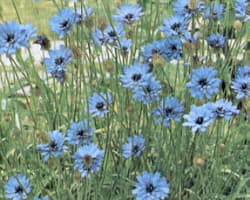How to Grow Cupid's Dart Flowers (Catanache Caerulea)

About Growing Cupid's Dart Perennial Flowers in Your Home Garden
Are you looking to grow an attractive, easy-to-grow perennial flower? Then, growing Cupid’s Dart flowers is the perfect answer. Cupid’s Darts are not known for their fragrance. However, these uncommon, true-blue daisies look great in a flowerbed and offer a striking contrast to other flowers in the bed. There are six species, including a white variety. The plants are deer-resistant, so you can grow them just about anywhere you want to enjoy their perky blooms.
Once established, perennial Cupid’s Dart plants will grow for years with little attention. They are drought-tolerant and don’t mind a little crowding. You can grow them in your flower garden. The plants are short-lived perennials. However, they are good re-seeders. Or, plant them in flowerpots to grow on your patio or deck. They will look beautiful wherever you plant them.
If you are looking for a plant for your window box, the shorter varieties can be your answer. They also look good in flowerpots on your balcony or deck. Just make sure they receive full sunlight for most or all of the day.
Bring the flowers indoors to brighten up your home. They are good fresh-cut in a vase. And, Cupid’s Dart look good in dried flower arrangements, too.
Cupid's Dart Plant Specifications
Flower Colors: The petals are a light purplish blue with dark blue centers. There are some white varieties, too.
Flowers Bloom: Summer to Fall.
Plant Height: 18″ – 24″
Light Requirements: Full sunlight.
Ideal Soil pH: 5.8 – 6.8.
Hardiness Zone: 4 – 8.
Deer Resistant? Yes. Deer do not eat the plants or flowers.
Native To: Mediterranean Region.
Plant Type: Short-lived Perennial.
Botanical Name: Catanache Caerulea
Medicinal Uses for Cupid's Dart
We have found no medicinal uses for Cupid’s Dart plants.
Light Requirements
Grow Cupid’s Dart plants in bright, full sunlight. They will tolerate a little shade in the early morning or just before sunset. But, be careful as too much shade results in lanky plants and fewer blooms.
Catanache Caerulea Plant Propagation
Cupid’s Dart is started from seed. They can be directly seeded into your flower garden or started indoors for transplanting later. The seeds take a long time to germinate. So, mark the planting site. If started early, they can bloom the first year.
For an early start, plant them indoors 6 to 8 weeks or more before the last frost in your area. Give young seedlings as much full sunlight as possible.
Cover Cupid’s Dart seeds lightly with soil, about 1/8″. Space seeds 3″-4″ apart. Thin seedlings to 12″ apart.
The plants can also spread through the root system. Use garden edging if you want to limit the spread of the plants.
Days to Germination: 21 – 25 days.
How to Grow Perennial Cupid's Dart Flower Plants
This is a very easy-to-grow plant. It is almost no maintenance.
The plants prefer full sun, and rich, well-drained soil. They are drought-tolerant plants.
Water them during extended dry periods, once or twice per week. Like other plants, for best results, keep the soil moist, but not wet.
Add a general-purpose fertilizer once a month.
Cupid’s Dart plants produce blue flowers on thin, wiry stems. Leaves are thin and grayish-green in color.
After flowers have died, pinch off the dead flower heads to promote new blooms. Also, deadheading helps to keep a neat and tidy appearance. Of course, if you are going to save seeds for next year, keep a few spent flowers on the plant until the dead bloom has completely dried. They are good re-seeders. So, allow some of the spent flowers on the plant to develop and ripen seeds Then, they will fall to the ground to replenish the planting site.
How to Dry Cupid’s Dart: Cut stems when the flowers just begin to show color, and before they are open. Tie the stems in bunches and hang them in a cool, dry, well-ventilated area.
Insect and Plant Disease
Cupid’s Dart plants are resistant to insects and disease. Mildew problems may occur in warm, humid weather. If insect or disease problems occur, treat the problem early with a general purpose fungicide.
Also see: Plant Problems – Identify the causes and find the cures.
Pruning Cupid's Dart Plants
Generally, pruning the plants is not necessary. Use a sharp pair of pruners to remove the occasional dead or sick leaves or stems.
Deadheading the spent blooms promotes new flower buds to form on the plant.
Overwintering Cupid's Dart Plants
If you are not growing these plants as an annual, there is little you need to do at the end of the season. In colder regions, add a thick layer of mulch around the plants to protect the roots from hard freezes.
Related Articles
People who read this article will also like:
How to Grow Cupid’s Dart Plants – by Garden Hobbies
Deadheading Flowers – It helps to promote new blooms and many plants. Also, it keeps the plant looking neat and tidy.
Please support our site. Shop for:
- rmmatthews100@hotmail.com
- 585-721-6528
- Rochester, NY
©1999-2024 GardenersNet.Com, All Rights Reserved

